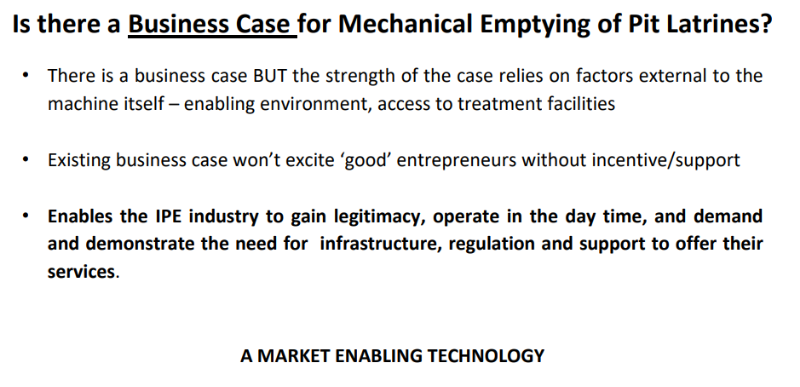- Forum
- categories
- Sanitation systems
- Faecal sludge management (FSM)
- Faecal sludge transport (including emptying of pits and septic tanks, transfer stations)
- Improved Pit Emptying Technology
Improved Pit Emptying Technology
39.6k views
- Elisabeth
-
- User is blocked
- Freelance consultant since 2012
Less- Posts: 3372
- Karma: 54
- Likes received: 932
Re: Improved Pit Emptying Technology
I'd like to bring to your attention a presentation by Dr. Nicola Greene on
"Is there a Business Case for Mechanical Emptying of Pit Latrines? - A closer look at the ‘formal’ pit latrine emptying market"
They used the new equipment called "The Excluder" as a case study which is why I am posting this into this existing thread which started out with information about the Excluder.
The presentation was given at FSM5 in Cape Town in Feb 2019 and is available on the SuSanA website here: fsm5.susana.org/images/FSM_Conference_Ma...y/3.Nicola-FSM-5.pdf
It's an interesting presentation. The second last slide is this one:
(IPE stands for informal pit emptying, I think)
Do you agree with the statements made in this presentation? And who else is doing research on this?
Elisabeth
"Is there a Business Case for Mechanical Emptying of Pit Latrines? - A closer look at the ‘formal’ pit latrine emptying market"
They used the new equipment called "The Excluder" as a case study which is why I am posting this into this existing thread which started out with information about the Excluder.
The presentation was given at FSM5 in Cape Town in Feb 2019 and is available on the SuSanA website here: fsm5.susana.org/images/FSM_Conference_Ma...y/3.Nicola-FSM-5.pdf
It's an interesting presentation. The second last slide is this one:
(IPE stands for informal pit emptying, I think)
Do you agree with the statements made in this presentation? And who else is doing research on this?
Elisabeth
Dr. Elisabeth von Muench
Freelance consultant on environmental and climate projects
Freelance consultant on environmental and climate projects
Attachments:
-
 businesscase.png
(Filesize: 147KB)
businesscase.png
(Filesize: 147KB)
Please Log in to join the conversation.
You need to login to reply- rochelleholm
-
 Less
Less- Posts: 99
- Karma: 4
- Likes received: 38
Hi AW,
Thank you for your question. Public toilets for households are not common in northern Malawi.
For more details on the emptying business in two cities of Northern Malawi, you may be interested in this publication:
Sanitation service delivery in smaller urban areas (Mzuzu and Karonga, Malawi)
by: Rochelle H Holm, Alinafe Kamangira, Mavuto Tembo, Victor Kasulo, Hastings Kandaya, Peter Gijs Van Enk and Alex Velzeboer
Environment & Urbanization
DOI: 10.1177/0956247818766495
Abstract: This paper assesses the provision of sanitation services in two urban areas in northern Malawi, both with populations under 150,000, to determine the potential for private sector enterprises to contribute to longer term self-reliance as part of the overall sanitation situation. The paper shows that most households in the two study areas use pit latrines and remain unserved with regard to both faecal sludge management and solid waste removal. Local governments have been unable to offer adequate coverage of sanitation services, and community-based organizations are doing very little that is relevant to the issue. This gap offers a viable business opportunity for private sanitation service providers. Of these two urban areas, Karonga Town has no formal private sector services, but Mzuzu City has pit emptying and solid waste collection services, plus some small-scale manufacturers of pre-made pit latrine slabs. The paper explores these activities, considering their accessibility to low-income customers. It closes with suggestions regarding the potential for building on what is currently available.
To help you access the full article, please visit: journals.sagepub.com/doi/full/10.1177/0956247818766495
Thank you for your question. Public toilets for households are not common in northern Malawi.
For more details on the emptying business in two cities of Northern Malawi, you may be interested in this publication:
Sanitation service delivery in smaller urban areas (Mzuzu and Karonga, Malawi)
by: Rochelle H Holm, Alinafe Kamangira, Mavuto Tembo, Victor Kasulo, Hastings Kandaya, Peter Gijs Van Enk and Alex Velzeboer
Environment & Urbanization
DOI: 10.1177/0956247818766495
Abstract: This paper assesses the provision of sanitation services in two urban areas in northern Malawi, both with populations under 150,000, to determine the potential for private sector enterprises to contribute to longer term self-reliance as part of the overall sanitation situation. The paper shows that most households in the two study areas use pit latrines and remain unserved with regard to both faecal sludge management and solid waste removal. Local governments have been unable to offer adequate coverage of sanitation services, and community-based organizations are doing very little that is relevant to the issue. This gap offers a viable business opportunity for private sanitation service providers. Of these two urban areas, Karonga Town has no formal private sector services, but Mzuzu City has pit emptying and solid waste collection services, plus some small-scale manufacturers of pre-made pit latrine slabs. The paper explores these activities, considering their accessibility to low-income customers. It closes with suggestions regarding the potential for building on what is currently available.
To help you access the full article, please visit: journals.sagepub.com/doi/full/10.1177/0956247818766495
Rochelle Holm, Ph.D., PMP
Mzuzu (Malawi)
Mzuzu (Malawi)
Please Log in to join the conversation.
You need to login to reply
Hi Rochelle,
According to the numbers you provided, there are about 30,000 households and the one professional emptier services 1% of the available households. That makes 300 households per year, roughly one per day - that makes sense. How are the other 99% of the households managing their waste? Are the informal emptiers taking care of the other 99%? Who are the informal emptiers? Are the other households relying on public toilets?
Cheers,
AW
According to the numbers you provided, there are about 30,000 households and the one professional emptier services 1% of the available households. That makes 300 households per year, roughly one per day - that makes sense. How are the other 99% of the households managing their waste? Are the informal emptiers taking care of the other 99%? Who are the informal emptiers? Are the other households relying on public toilets?
Cheers,
AW
Andrew Whitesell
President/Founder of Beaumont
President/Founder of Beaumont
Please Log in to join the conversation.
You need to login to reply- csk
-

- I work on the toilet, sanitation, biogas, FSM, environmental science and engineering, and I hope to contribute to the toilet revolution in China and in the global. I am happy to share Chinese WASH story.
Less- Posts: 42
- Karma: 1
- Likes received: 15
Agree! In many places, the pit latrine is used also as a garbage tank.
Shikun Cheng,
Professor, Ph.D
Center for Sustainable Environmental Sanitation (CSES)
Department of Environmental Science and Engineering
University of Science and Technology Beijing (USTB)
This email address is being protected from spambots. You need JavaScript enabled to view it.
Professor, Ph.D
Center for Sustainable Environmental Sanitation (CSES)
Department of Environmental Science and Engineering
University of Science and Technology Beijing (USTB)
This email address is being protected from spambots. You need JavaScript enabled to view it.
Please Log in to join the conversation.
You need to login to reply- rochelleholm
-
 Less
Less- Posts: 99
- Karma: 4
- Likes received: 38
Dear Andrew
In the city of Mzuzu, the average number of individuals per household is five.
The average pit volume is 825 L.
The service price for a typical fecal sludge removal job with disposal at the city liquid waste ponds is around US$20 to US$ 30. There is one provider in Mzuzu, and the company’s reach for low-income households is less than 1 per cent of the city’s population.
The contents are dry.
Best of luck with your project.
Rochelle
In the city of Mzuzu, the average number of individuals per household is five.
The average pit volume is 825 L.
The service price for a typical fecal sludge removal job with disposal at the city liquid waste ponds is around US$20 to US$ 30. There is one provider in Mzuzu, and the company’s reach for low-income households is less than 1 per cent of the city’s population.
The contents are dry.
Best of luck with your project.
Rochelle
Rochelle Holm, Ph.D., PMP
Mzuzu (Malawi)
Mzuzu (Malawi)
Please Log in to join the conversation.
You need to login to reply
Hi Rochelle,
Could you provide a few details about pit emptying in Malawi - what is the typical number of people in a household? What is the average pit volume? What is the consistancy of the contents? What is the cost of emptying? And, where is the exhausted sludge disposed of?
Thanks,
Andrew
Could you provide a few details about pit emptying in Malawi - what is the typical number of people in a household? What is the average pit volume? What is the consistancy of the contents? What is the cost of emptying? And, where is the exhausted sludge disposed of?
Thanks,
Andrew
Andrew Whitesell
President/Founder of Beaumont
President/Founder of Beaumont
Please Log in to join the conversation.
You need to login to reply- Elisabeth
-
- User is blocked
- Freelance consultant since 2012
Less- Posts: 3372
- Karma: 54
- Likes received: 932
Re: Improved Pit Emptying Technology - Flexcrevator
An update about this Flexcrevator (pit emptying tool) was recently provided by Giovanna Portiolli. You can access her presentation from the FSM5 conference in February here:
"The Flexcrevator: Development and Field Testing of Mechanized Pit Emptying with Trash Exclusion"
fsm5.susana.org/images/FSM_Conference_Ma...resentation_FdlR.pdf
The summary slide said:
Trash Exclusion mechanism worked in the field; new design ready
- Trash exclusion will
bring multiple
benefits
- Swappable excluder
head to adapt to
specific characteristics
of various pit latrines
- The clearing
mechanism proved to
be efficient in simulated
and real pit latrines
- Opportunity to use the
excluder head in
conjunction with
vacuum trucks (and
basic pumps)
(See more FSM5 presentations here: fsm5.susana.org/en/downloads/conference-materials)
"The Flexcrevator: Development and Field Testing of Mechanized Pit Emptying with Trash Exclusion"
fsm5.susana.org/images/FSM_Conference_Ma...resentation_FdlR.pdf
The summary slide said:
Trash Exclusion mechanism worked in the field; new design ready
- Trash exclusion will
bring multiple
benefits
- Swappable excluder
head to adapt to
specific characteristics
of various pit latrines
- The clearing
mechanism proved to
be efficient in simulated
and real pit latrines
- Opportunity to use the
excluder head in
conjunction with
vacuum trucks (and
basic pumps)
(See more FSM5 presentations here: fsm5.susana.org/en/downloads/conference-materials)
Dr. Elisabeth von Muench
Freelance consultant on environmental and climate projects
Freelance consultant on environmental and climate projects
Please Log in to join the conversation.
You need to login to reply
Hello all,
We (Flexcrevator team from NC State) have been quiet for a while as we did field testing of several designs for trash exclusion.
We're happy to report that we have a nearly complete design that we tested in June/July in Kisumu, Kenya, taking the learnings from the previous testing in Lusaka, Zambia.
We hope to present the design at FSM5. Results from testing in Kisumu, Kenya (with assistance from WSUP and KIWASCO) are summarized below:
The prototypes were tested in several wet and dry pits with trash. The clearing auger-Flexcrevator was able to successfully and completely exclude trash in wet pits, with flow rates ranging from 3 to 4 lps. Emptying 1 m3 of FS took a total pump time of 3.8 min, and a total time (including handling barrels) of 27 min. Thus, the pump time was only 14% of the total operation time.
The Flex Excluder was attached to a commercial vacuum truck, and 4.7 m3 of trash-free FS was pumped out in 14 min (5.6 lps). In thicker sludge (> ~12% solids) the flow rates were much lower, ranging from 0.2 to 0.75 lps. Blocking due to fibrous material such as hair and food fiber were also a challenge in thicker sludge. The results of field testing, including the effect of sludge thickness and solids content, hole sizes, auger material, auger clearance, trash types and amounts, deflection vs. clearing, operation, user and customer feedback, among others will be presented at FSM5 (hopefully).
We apologize that we cannot share final design yet- we are in the process of making some tweaks to solve the issue with hair and fiber in thicker sludge (not watery sludge).
We (Flexcrevator team from NC State) have been quiet for a while as we did field testing of several designs for trash exclusion.
We're happy to report that we have a nearly complete design that we tested in June/July in Kisumu, Kenya, taking the learnings from the previous testing in Lusaka, Zambia.
We hope to present the design at FSM5. Results from testing in Kisumu, Kenya (with assistance from WSUP and KIWASCO) are summarized below:
The prototypes were tested in several wet and dry pits with trash. The clearing auger-Flexcrevator was able to successfully and completely exclude trash in wet pits, with flow rates ranging from 3 to 4 lps. Emptying 1 m3 of FS took a total pump time of 3.8 min, and a total time (including handling barrels) of 27 min. Thus, the pump time was only 14% of the total operation time.
The Flex Excluder was attached to a commercial vacuum truck, and 4.7 m3 of trash-free FS was pumped out in 14 min (5.6 lps). In thicker sludge (> ~12% solids) the flow rates were much lower, ranging from 0.2 to 0.75 lps. Blocking due to fibrous material such as hair and food fiber were also a challenge in thicker sludge. The results of field testing, including the effect of sludge thickness and solids content, hole sizes, auger material, auger clearance, trash types and amounts, deflection vs. clearing, operation, user and customer feedback, among others will be presented at FSM5 (hopefully).
We apologize that we cannot share final design yet- we are in the process of making some tweaks to solve the issue with hair and fiber in thicker sludge (not watery sludge).
Francis de los Reyes III
Professor/TED Fellow
Professor/TED Fellow
Please Log in to join the conversation.
You need to login to reply- nicolag
-
 Topic Author
Topic Author- Sanitation Engineer - Consultant
Less- Posts: 46
- Karma: 4
- Likes received: 13
Rochelle - thank you ,that is a useful way to think about defining the market for one unit.
Very helpful Georges - thank you! I agree with what you say; I think those are similar thoughts to mine but expressed a lot more clearly. It seems like the next stage would need to a technical validation stage with those 'ideal' partners I think the question applies not only to the Flexcrevator, but maybe also to the eVac, the ROM, the Earth Auger etc.
There are some nifty products out there but the hurdle/expense to actually reach the market post product development seems universally underestimated. Do we have any success stories of new tech penetration via partners in this sector (or similar?!) Do we have any organisations specifically focusing on bridging this early stage market entry gap? Also interested if anyone has recommended reading around this, or indeed, business contacts who have gone through this process with tech before.
@georges in terms of those 'easier' market partners - who do you think we are looking at...
- Sanitation Solutions Group
- Pit Vidura
- Practica
- Sanergy
........?
@shaji - what configuration is preferable to you? Similar to the unit that @JKMakowka pointed out in the thread? That group reconfigured to pump directly to the road. For now the set -up of the Flexcrevator is to those barrels but that suits some markets and not others. I'd be interested to know what set up you would want.
Very helpful Georges - thank you! I agree with what you say; I think those are similar thoughts to mine but expressed a lot more clearly. It seems like the next stage would need to a technical validation stage with those 'ideal' partners I think the question applies not only to the Flexcrevator, but maybe also to the eVac, the ROM, the Earth Auger etc.
There are some nifty products out there but the hurdle/expense to actually reach the market post product development seems universally underestimated. Do we have any success stories of new tech penetration via partners in this sector (or similar?!) Do we have any organisations specifically focusing on bridging this early stage market entry gap? Also interested if anyone has recommended reading around this, or indeed, business contacts who have gone through this process with tech before.
@georges in terms of those 'easier' market partners - who do you think we are looking at...
- Sanitation Solutions Group
- Pit Vidura
- Practica
- Sanergy
........?
@shaji - what configuration is preferable to you? Similar to the unit that @JKMakowka pointed out in the thread? That group reconfigured to pump directly to the road. For now the set -up of the Flexcrevator is to those barrels but that suits some markets and not others. I'd be interested to know what set up you would want.
Please Log in to join the conversation.
You need to login to reply- shaji
-
 Less
Less- Posts: 18
- Likes received: 1
- rochelleholm
-
 Less
Less- Posts: 99
- Karma: 4
- Likes received: 38
In my observation in Malawi, towns with a population under 150,000 where pit latrines are a primary household system, only one formal emptying provider and a handful of informal emptiers can be sustained. In town of under 50,000 there are no regular formal providers.
In which case, I see that your ‘technology champions' would need to have a base population of more than 150,000 at least in their startup area.
Rochelle
In which case, I see that your ‘technology champions' would need to have a base population of more than 150,000 at least in their startup area.
Rochelle
Rochelle Holm, Ph.D., PMP
Mzuzu (Malawi)
Mzuzu (Malawi)
Please Log in to join the conversation.
You need to login to reply
Share this thread:
- Forum
- categories
- Sanitation systems
- Faecal sludge management (FSM)
- Faecal sludge transport (including emptying of pits and septic tanks, transfer stations)
- Improved Pit Emptying Technology
Recently active users. Who else has been active?
Time to create page: 0.203 seconds







